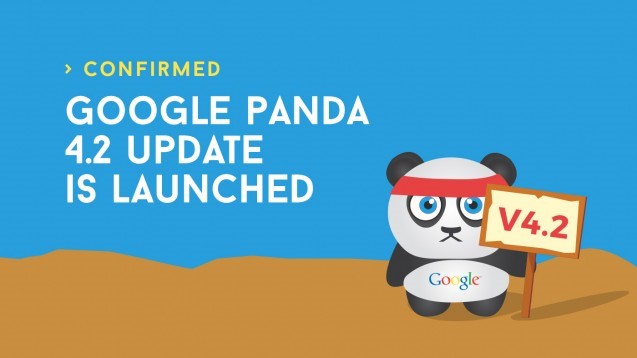
Aside from penguin, panda is one of the most common terms in search engine optimization.
But if you’re looking for an in-depth look at the algorithm update, its attributes, how it affects websites, and how you can use the update to your advantage – well, if you hadn’t stumbled upon this page, you’d be searching for quite a while.
This is your complete guide to understanding Google Panda and how it affects the stages of website creation. If you plan on receiving organic search traffic from Google (or you already are), make sure to read all of the way through so you’re not penalized – as you’ll see below, most of the time, a Panda penalty is permanent.
(If you have been hit with a penalty for Panda, contact an SEO professional today for a no-obligation on-site SEO audit.)
Table of Contents
Origin Panda Updates & Refreshes
The original Panda

Google originally rolled out Panda in early 2011 for US-based sites. More than 12% of queries were affected – almost double from the last major update prior to Panda. Google had made a brief announcement in January of 2010 describing their plans to address low-quality content, but few thought the impact would be so widespread.
Originally, the update targeted only sites with low-quality content. If you have ever stumbled upon an article, started reading, and found that the information was completely generic and utterly useless… that’s what we call low-quality content.
These types of sites pump out content that can rank for a keyword with minimal SEO effort due to lack of competition. When search engine traffic lands on their useless content, the hope the users will click through to the ads on the page – sometimes directly from Adsense.
But that’s pretty much the only goal. There is no focus on user value or retention what-so-ever. To the lazy, profit-driven webmaster, these sites are easy to build, easy to populate, and easy to monetize. To users, they’re terrible – and annoying to stumble upon in the search results.
As such, Google made a huge leap to eradicate them. After the initial 12% surge, the madness didn’t stop, though – not even close.
Scraper Update
Just a week later, Matt Cutts (who has since retired) confirmed suspicions that another update to Panda had rolled out, called the scraper update.
Scraping has many different connotations in the SEO world – in this case, the reference was aimed at those annoying, poorly-designed websites that literally do nothing but copy other websites word-for-word. We still see them sometimes in 2015 (especially in niches like lyrics), but it was a lot more prevalent way back in 2009 and 2010. You would search for a keyword, only for the first five results to be completely the same from one another – it was infuriating.
So, the scraper update eliminated most of these problems – nowadays, even if you’re pulling from a RSS feed by legitimate means, displaying that content on your website without the proper SEO formatting can result in a penalty.
Farmer Update
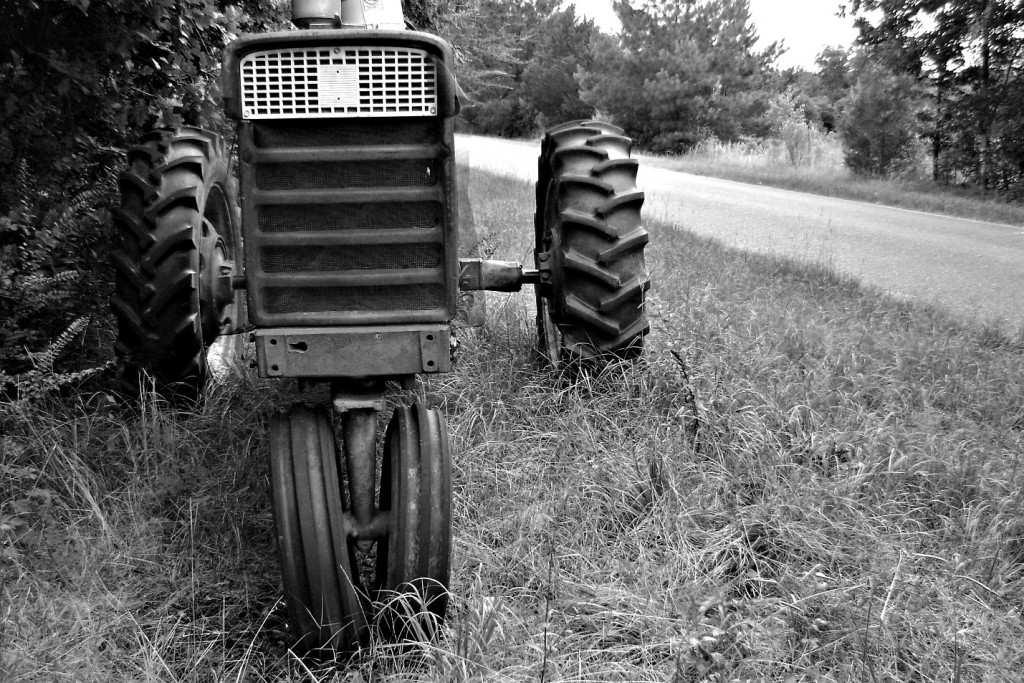
Danny Sullivan of Search Engine Land had discovered a reference to the next update being referred to as the farmer update – but Google said that the update didn’t explicitly affect content farms. The reasoning behind this was the potential to offend partners of Google – if a website was penalized during this update, it would be dubbed a “content farm”, regardless of quality. (You’ll see a little further on that some legitimate sites were penalized, making this a very smart precaution for Google to take.)
But by and large, most of the sites to get hit by the farmer update did deserve it.
One such example is eHow – though eHow had plenty of in-depth guides, some of them were completely useless and composed entirely of garbage filler content. There would be “guides” for topics that made no sense, and the “advice” was a bunch of feel-good nonsense.
Sites like eHow were hit by the farmer update to Panda. Many more were, too, as this problem of content existing but providing no value was very widespread. We’ll go over six big-name examples in just a second.
But first, here’s how Panda continues to plague webmasters to this day…
Panda Refreshes from 2011 – 2015
There hasn’t been another update since the farmer update, but there have been plenty of refreshes, which is the Panda algorithmic update being rolled out to a larger percentage of keyword queries. In essence, this means that even if a content farm does exist, it can be hit by the new refresh. And if a new content farm pops up in between refreshes, it will be hit, too.
To date, there have been over twenty refreshes, usually occurring a few months in between each other and sometimes emphasizing certain types of sites, such as gaming or lyrics sites.
You can find the dates and specifics of each update on on Moz’s complete Panda chart.
The impact of Panda
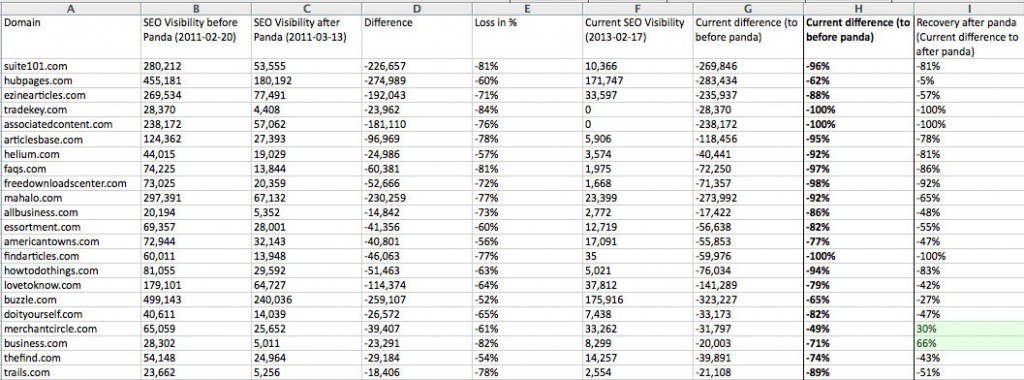
Throughout the years, Panda has solidified its reputation as the most fatal algorithm update because of the enormous and permanent effect it had on a variety of web-based businesses.
Let’s go through six interesting examples of Panda in action, explaining what these sites were doing, why they got penalized, what they tried to do to fix it – and of course, if they finally succeeded. (Most didn’t.)
User-Generated: HubPages
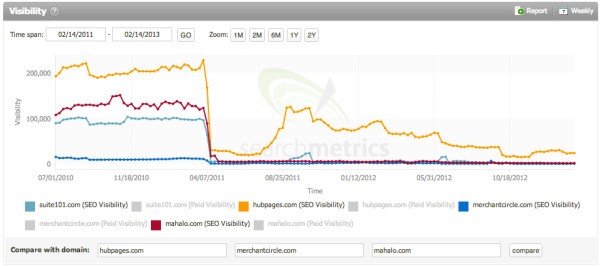
WordPress, Wix, and other heavily-promoted website creation platforms are the standard user publishing 2015, but back in 2011, the go-to publisher of user content was a web 2.0 site called HubPages. Users could sign up for free and post whatever they wanted, including dofollow links.
The site relied entirely on user-generated content, and because of the SEO value it held, it indirectly relied on spam “content”, too. It was rare that you would find a HubPages result that actually helped you answer a question or find information. They were designed poorly, hard to read, and just void of information or any real data.
Thus, Panda hit HubPages – and Panda hit hard. The “quantity over quality” approach (they had 1.1 million indexed pages) led to HubPages dropping sharply from first to last. They lost over 90% of traffic when the first update hit, and although they were able to temporarily increase that number, it never came close to hitting its former peak.
Traffic remains below today, and while users still do use HubPages, the company is looking for alternative ways to monetize the platform.
Paid User-Generated: Associated Content
Many will remember Associated Content as being the go-to “make money online” recommendation – you would type up an article, submit the piece, and if it didn’t completely suck, you would get paid an outrageously low fee – usually in the range of $2 – $3 for a 500 to 700 word article.
Can you imagine if you paid a pack of freelancers at even the best rates that Associated Content offered to most writers – close to $3 for 500 words? Your entire website would be illegible, and if the articles were readable, they wouldn’t provide any real value or even contain any real research. Paying for content is like paying for time, and low rates ensures that very little time or effort is invested.
So, Associated Content was full of low-quality content. After Panda hit, over “75% of their pages” were receiving “significantly less traffic”, according to a spokesperson from Yahoo.
But being Yahoo (a big, global brand), they didn’t just give up like HubPages did. Instead, Yahoo scrapped the Associated Content name, deleted over 75,000 junk articles (and presumably many more after the fact), and finally moved the portal to voices.yahoo.com – a much more trusted domain name.
With the drastic changes, voices.yahoo.com was able to recover – for a time. Eventually, though, Yahoo Voices shut down, and although no official statement was made, Panda likely had a major impact on that decision. (Associated Content was a profitable asset before Panda – Yahoo bought it for $100 million, and at the time, that figure was considered to be a good deal.)
General: Mahalo
Mahalo started off with so much promise – and took a dark turn for the worse.
Originally, the website was geared towards creating pages for common search topics, but quality pages at that. Later, a Q/A section was added, and the content quality deteriorated – but Google still loved Mahalo (and other similar sites, such as Wisegeek).
After Panda, Google didn’t move Mahalo. It was like an immediate, ugly breakup.
The site lost just under 80% of its traffic within a month, and two years after the update, the site was doing even worse than before in terms of search engine visibility. Read the statement on the site’s new direction here.
The brand has fallen from a Wisegeek competitor to a no-name – and all because they didn’t fear Panda. (Wisegeek is still trucking along, though like Mahalo, traffic numbers are nowhere near where they used to be.)
Industry-Specific: MotorTrend
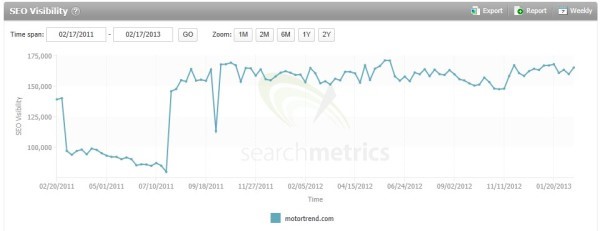
MotorTrend.com isn’t really an observation on how Panda affects websites, but it is an interesting look into how Google can sometimes “get it wrong”.
MotorTrend was hit when the first Panda update rolled out – the one that affected 12% of US sites. Website traffic dropped sharply.
Then, MotorTrend recovered.
Then, MotorTrend dropped again, just a few months later…
Then, Motortrend recovered again – this time for good.
Today, MotorTrend continues to be a publisher of valuable content – look on the site and you’ll see the articles are all of the highest quality.
And they always have been.
But sometimes, Google doesn’t get it right.
Big Player: About.com
Last but not least is a website that escaped Panda by the neck on the back of its hair – About.com.
About.com is your classic content farm – the website is geared towards explaining different topics. And overall, their explanations are pretty darn good. If you land on an About.com page in the search engines, you’ll get the information you’re after.
However, it wasn’t always that way – some of the articles used to be “meh” at best in terms of value delivered. As a result, About.com suffered a substantial hit for a “moderately negative number of page views”, according to one spokesperson.
Apparently, the impact was far more – About.com ended up selling for $110 million less than it was purchased for, and part of that was presumable due to Panda. (They’re not such innocent creatures, after all.)
Thank Goodness: EzineArticle & Others
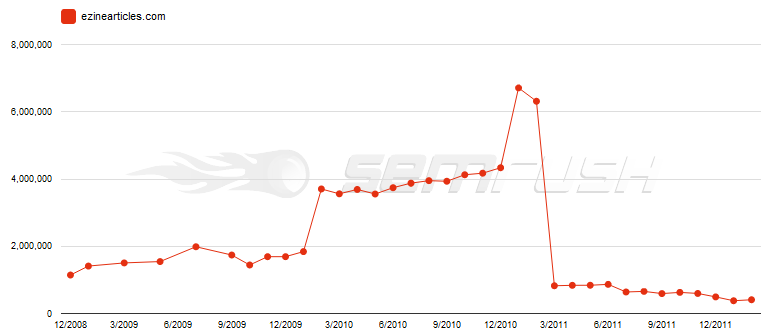
EzineArticles and pretty much every other “article directory” on the planet was hit hard on the first round of Panda. The effects did not stop, and these sites are now nowhere to be seen. The pages themselves no longer carry any weight for SEO (even blackhat SEO), either, so these days, the article directories are truly deceased.
As you can see, most websites did not recover from Panda – even the big ones with massive amounts of backing capital and manpower.
Don’t go the same path that they did – instead, just make sure your content is on point the first time around.
New guidelines for web content after Panda
General Guidelines

If you’re publishing content, make sure it’s Panda-worthy – period! As mentioned above, the standards for Panda are highly debated. In general, though, if the article is free of grammar and spelling errors – and provides real value to the reader – then it’s safe to use. You don’t need an English professor writing your content, but you also can’t have your 13-year-old neighbor doing it, either.
Focus on quality over quantity. As you’re paying more for or spending more time on content, your resources will be strained. Unless you want to take an approach like a defunct content farm, target larger, broader subjects and focus your SEO budget on lucrative keywords with substantial monthly traffic numbers. These days, one pillar article is (usually) better than 10 micro articles.
Stop paying attention to word count. Quicksprout gives a good explanation on the “word count myth” here. You don’t want to fill up space for the sake of filling up space. On any given query, you’ll see an assortment of content pieces ranking, some as low as 500, some as high as 5,000 – it’s all relevant to the specific query.
A page of fluff is a page or poor content, in the eyes of both Panda and the visitor. Contact us today and we’ll give you our no-obligation opinion on whether or not your website is Panda-worthy.
Content Guidelines
Writing content yourself

If you’re still in the beginner stages of search engine optimization and building out your first few sites, we recommend you stick with topics that interest you, or at least ones that you wouldn’t mind doing some research on to become an expert.
It goes like this: An amateur can’t teach another amateur about a subject in a meaningful way. If you are writing your own content, in order to be a Panda-accredited writer (not a real thing, unfortunately), you have to be the expert.
So, pick something you know – like one of your hobbies, assuming there are lucrative keywords within that – or something you wouldn’t mind researching, like something you’ve always been interested in but have never had the time to pursue.
Buying content

Most webmasters delegate content creation to freelancers and/or in-house writers. Using this option, you have limited time, so you need to optimize your process if you hope to publish any substantial amount of content. You can’t be editing, fact-checking, and proofreading every article that comes across your desk.
We’ll break down the optimal process for this method of generating content into a 5-point process.
- Start with one or two writers. Be very clear in your writing instructions, and even if you don’t hire the best of the best, make sure you don’t hire complete amateurs, either. A kid who decided to write articles after school can’t produce Panda-worthy content.
- Work with your writers until they know what to do. Chances are, your first few articles won’t be perfect. Ask for revisions, and if they’re still not getting it, drop them and find new, more adept writers.
- Continue editing their next few articles, just to be sure. You don’t want to risk including a poor article and catching the eye of Panda, even if you didn’t mean to publish low-quality content. Ignorance is no excuse!
- Allow them to write and post themselves. Once you trust each of your writers, instruct them on your CMS and let them write, insert pictures, format articles, and even post articles themselves. If you’re hiring intelligent writers, you may even be able to outsource keyword and topic generation.
- Onboard one or two more writers and repeat the process. Once your first batch of writers is adding Panda-worthy content on a consistent basis, expand until you have an entire team.
If you hire anyone and post anything, you’re asking for trouble – or at least a lot of wasted hours trying to make sure your content is appropriate.
Put in the work first, get a solid team of writers… then start creating content that you want to rank for the long term.
Allowing users to post content

Seeing as Panda targeted quite a few websites just like this, your strategy moving into 2015 has to be more calculated. The user-generated content sites that have been hit by Panda have not recovered, most likely due to the sheer mass of low-quality content on the site.
- At least to start, remove dofollow. The easiest way to invite automated signups and posts is by signalling your platform is ripe for link juice.
- Make the platform impossible to post on. Even if a spammer discovers your site and your URL gets on a “list”, spammers shouldn’t be able to make it through. Recaptcha and a customized signup process is a good start – custom security elements are even better!
- Let users regulate themselves. You can’t be looking at every single page. Rely on your users spotting junk and reporting it to you – this only works if you have a minimal amount of spam and a high number of active users.
- Implement some sort of spam detection system. The most basic example is a script that flags words like viagra, porn, etc. When you pick up on spam, either block posts automatically, or, if you’re trying to establish yourself and need all of the content you can, put them under review until you can moderate.
- Just don’t do it. These days, companies like Wix are trying to transition from content creation to a SaaS model. Instead of monetizing user-generated content, companies are forcing users to pay for the privilege to post in the first place. With the dwindling number of sites using user-generated content from regular users (not real writers), a path like this might be more feasible four years after Panda was released.
The Recap: Google Panda & How it Affects Website Creation

The guide above can be summarized into five neat, concise points. If you’re new to SEO and you need a Panda handbook at your side at all times, write down the following five points and follow them religiously.
Content might not be king… but it’s certainly important. Although SEO professionals debate the importance of content vs. backlinks, we now know that with poor content, you’re setting yourself up for failure right off the bat. Past that, the efficacy of superior content vs. superior backlinks is still highly debated.
Panda refreshes constantly, so don’t think you’ve “found a workaround”. If you’re somehow ranking purely-junk content, you will get hit when Google decides to clean the SERPs up. We guarantee it.
Anyone can get hit by Panda. All types of websites. All niches. Even the sites that don’t have any problems, like MotorTrend, can get hit. Don’t think that Panda is something you can shrug off – even websites generating millions of dollars in clicks for Google’s advertising program, Adsense, were affected.
Focus on quality over quantity. And we mean it. It’s tempting to write three mediocre articles to try and rank for three keywords right away through off-page SEO, but in 2015, it’s smarter to spend more time on one article and ensure that it keeps its rankings for one keyword throughout the Panda refreshes.
Finally, content creation has become a science. You now have to balance cost (either your time or your money) with quality. You can no longer just post anything… though, like we’ve said over and over again, your content doesn’t have to resemble a doctoral thesis, either. (Sometimes, more casual content is even preferred, such as on a site like TMZ.)
Got it? Good.
Time to get to work. If you’re building a new site, get started on producing that exemplary content that Google will love – every time a Panda refresh comes around, you’ll climb a few ranks over the poor-quality content farms.
If you already have a site, look through to make sure you’re not making the Panda angry – then, get to work on those valuable articles that will rank for years down the line.
And if you need someone to handle the hard work for you, contact SEO professionals today. We have helped hundreds of businesses just like yours avoid and recover from Panda penalties. Let’s get you on track towards solid rankings – not rankings that disappear during every Panda refresh.
Good luck!






